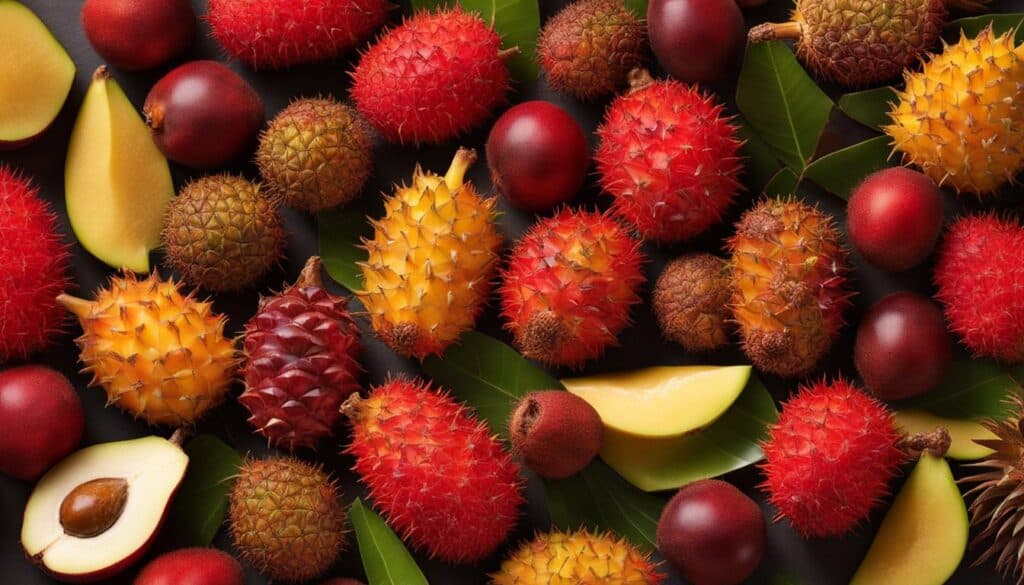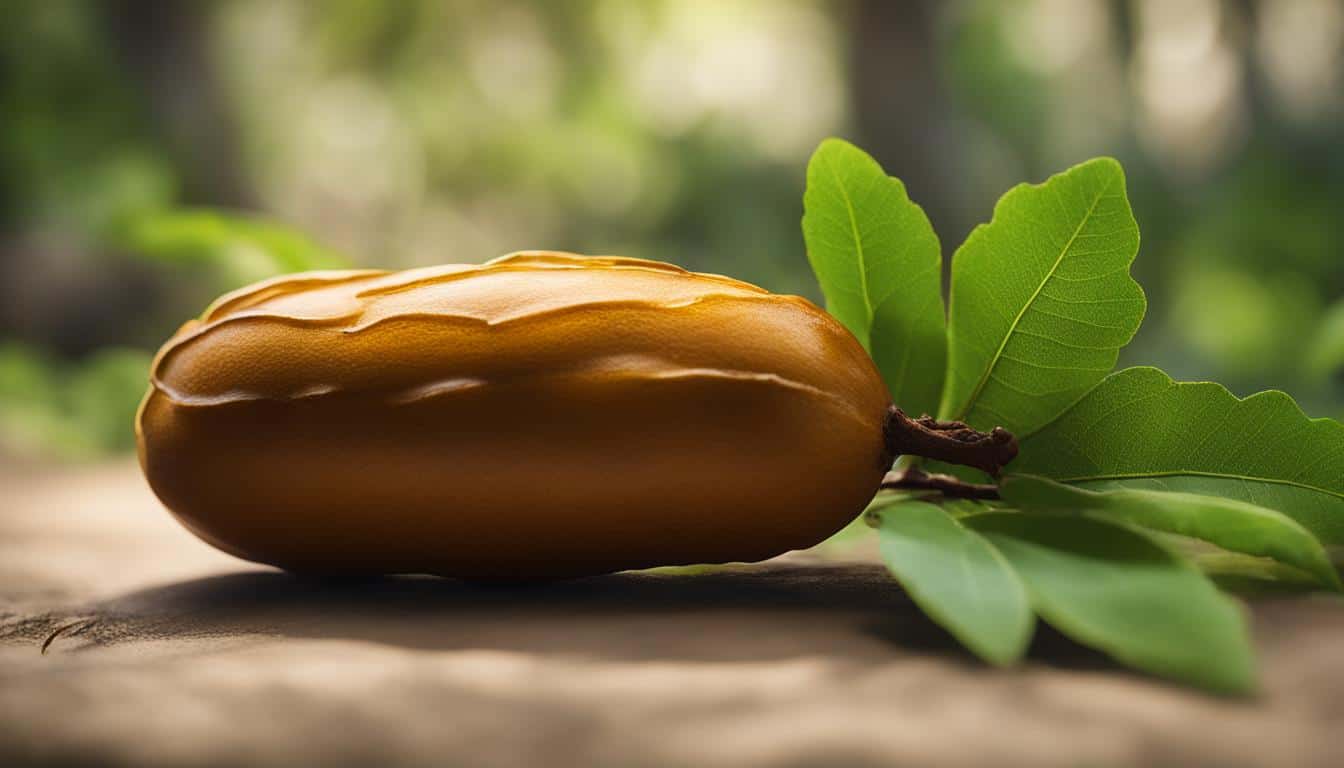Are you ready to embark on a flavorful adventure? Join me as we explore the delightful world of sweet tamarind, an exotic fruit that promises a unique taste experience. With its sticky, long, brown pod-like appearance, sweet tamarind may initially seem like an exotic vegetable. But don’t be fooled! Once you break through the thin crust, you’ll discover a sweet, slightly dull-tasting dark mass with inedible seeds.
Sweet tamarind can be found all over Thailand and is commonly enjoyed fresh. Its distinctive flavor and versatile uses make it a valuable addition to any culinary repertoire. So, let’s dive in and discover the captivating flavors and characteristics of sweet tamarind together!
Key Takeaways:
- Sweet tamarind is an exotic fruit with a sticky, long, brown pod-like appearance.
- Once you break through its crust, you’ll find a sweet, slightly dull-tasting dark mass with inedible seeds.
- Sweet tamarind is commonly found in Thailand and is enjoyed fresh.
- Its unique flavor and versatility make it a valuable ingredient in various dishes.
- Join me on this flavorful adventure as we explore the delicious world of sweet tamarind!
The Health Benefits of Sweet Tamarind
Sweet tamarind not only tantalizes your taste buds but also offers several health benefits. Packed with essential nutrients, this exotic fruit can be a valuable addition to your diet. Here are some of the key health benefits of sweet tamarind:
- Rich in Vitamin C: Sweet tamarind is a great source of vitamin C, which plays a vital role in supporting the immune system and promoting overall health.
- Powerhouse of Antioxidants: This fruit is also rich in antioxidants, which help protect the body against damage from harmful free radicals.
- Anti-Inflammatory Properties: Sweet tamarind contains compounds that have anti-inflammatory properties, making it beneficial for reducing inflammation in the body.
- Digestive Aid: The natural fiber found in sweet tamarind can help promote healthy digestion and prevent constipation.
- Heart-Healthy: Consuming sweet tamarind may help lower cholesterol levels and reduce the risk of heart disease.
- Boosts Iron Levels: Sweet tamarind is a good source of iron, an essential mineral that helps transport oxygen throughout the body.
Including sweet tamarind in your diet can be a delicious way to enhance your overall well-being. Whether enjoyed fresh or incorporated into various recipes, this exotic fruit offers a unique combination of flavors and health benefits.
I love incorporating sweet tamarind into my meals not only for its delightful taste but also for its numerous health benefits. It’s a versatile ingredient that adds a tangy and slightly sweet flavor to both savory dishes and desserts. Plus, knowing that it’s packed with essential nutrients and antioxidants makes me feel even better about indulging in its deliciousness.
Various Uses of Sweet Tamarind
Sweet tamarind is a versatile fruit that adds a tangy and sweet flavor to a wide array of culinary creations. From savory dishes to refreshing beverages and desserts, sweet tamarind offers a delightful taste experience. Let’s explore the various uses of sweet tamarind and discover how this exotic fruit can elevate your meals.
Dishes: In Asian cuisine, sweet tamarind is commonly used in a variety of dishes. Its tangy flavor pairs well with curries, stir-fries, and noodle dishes, adding complexity and depth. Tamarind-infused sauces and marinades are also popular, lending a sweet and sour element to grilled meats and seafood.
Sauces: Tamarind sauce is a versatile condiment that can be used to enhance the flavors of many dishes. It can be drizzled over roasted vegetables, used as a dipping sauce for spring rolls or samosas, or brushed onto grilled meats for a flavorful glaze.
Beverages and Desserts: Sweet tamarind can be used to create refreshing beverages like tamarind juice or agua fresca. Its tangy and sweet taste provides a unique twist to traditional fruit punches. Additionally, sweet tamarind can be incorporated into desserts such as tamarind sorbet, tarts, and candies, offering a burst of tropical flavor.
Tamarind Sauce Recipe
If you’re looking to add a tangy kick to your meals, try making your own tamarind sauce. Here’s a simple recipe to get you started:
“Tamarind sauce recipe”
- In a saucepan, combine 1 cup of tamarind paste, ⅓ cup of brown sugar, 1 tablespoon of soy sauce, 1 minced garlic clove, 1 teaspoon of grated ginger, and a pinch of chili flakes.
- Simmer the mixture over low heat, stirring occasionally, until the sugar has dissolved and the sauce has thickened slightly, about 10 minutes.
- Remove from heat and let the sauce cool before transferring it to a jar or bottle for storage.
- Enjoy the tamarind sauce drizzled over your favorite dishes or as a dipping sauce for spring rolls, fried tofu, or grilled chicken.
With its versatile nature and unique taste, sweet tamarind is a valuable ingredient that can transform your meals from ordinary to extraordinary. Experiment with different recipes and discover the endless possibilities that this exotic fruit offers.
How to Eat Sweet Tamarind

Eating sweet tamarind is simple, but it requires a little bit of preparation. To enjoy this exotic fruit, begin by breaking through its thin crust to reveal the sticky, dark mass inside. You can use your fingers or a knife to gently pry it open. Once opened, you’ll find inedible seeds that should be removed and discarded. It’s best to do this by hand, making sure not to leave any seeds behind.
Now that you have the sweet tamarind flesh ready, you can enjoy it in various ways. One option is to eat it directly from the fruit itself. Take a small piece, place it in your mouth, and savor the unique combination of sweet and slightly dull flavors. The stickiness may take some getting used to, but it adds to the experience.
If you prefer to incorporate sweet tamarind into your recipes, there are countless possibilities. Its tangy taste makes it a popular ingredient in both sweet and savory dishes. You can use it to make sauces, chutneys, curries, marinades, and even drinks. The possibilities are endless, and its unique flavor will add a delightful twist to any recipe.
How to Make Tamarind Sauce
If you want to try your hand at making tamarind sauce, here’s a simple recipe to get you started:
- In a saucepan, combine 1 cup of water, 1 cup of sweet tamarind pulp, 1/4 cup of sugar, and a pinch of salt.
- Bring the mixture to a boil, then reduce the heat and let it simmer for about 10 minutes.
- Remove the saucepan from the heat and let the mixture cool. Once cooled, strain the sauce to remove any remaining fibers or seeds.
- Your homemade tamarind sauce is now ready to be used as a dip, marinade, or dressing!
Whether you enjoy sweet tamarind on its own or incorporate it into your favorite dishes, this exotic fruit is sure to delight your taste buds. Its unique flavor, combined with its health benefits, makes it a valuable addition to any culinary repertoire. So go ahead, give sweet tamarind a try and discover a whole new world of flavors.
Tamarind Consumption Tips
“When eating tamarind, remember to drink plenty of water to help reduce any stickiness in your mouth. You can also try sucking on a small piece of lemon or lime to cleanse your palate.”
Health Benefits of Sweet Tamarind
| Health Benefit | Description |
|---|---|
| Aids Digestion | Rich in dietary fiber, sweet tamarind can help promote healthy digestion and prevent constipation. |
| Boosts Immune System | With its high vitamin C content, sweet tamarind can support a healthy immune system and protect against common illnesses. |
| Improves Heart Health | The potassium and magnesium in sweet tamarind can help regulate blood pressure and promote cardiovascular health. |
| Provides Antioxidants | Loaded with antioxidants, sweet tamarind can help protect cells from damage caused by free radicals. |
| Promotes Healthy Skin | The vitamins and antioxidants in sweet tamarind can contribute to healthy skin, reducing signs of aging and promoting a youthful complexion. |
Enjoying sweet tamarind not only delights your taste buds but also provides a range of health benefits. From aiding digestion to boosting the immune system, this exotic fruit is a valuable addition to a healthy diet.
Where to Buy Sweet Tamarind
If you are intrigued by the exotic taste of sweet tamarind and want to try it for yourself, you may be wondering where to purchase this fruit. Sweet tamarind can be found in specialty Asian grocery stores, international markets, or even online. Fresh sweet tamarind is often sold in long pods, while packaged tamarind products like sauces and candies are also available. Explore your local options or browse online platforms to discover the best sources for buying sweet tamarind.
Local Specialty Asian Grocery Stores
One great place to find sweet tamarind is at local specialty Asian grocery stores. These stores often carry a wide variety of exotic fruits and ingredients, including fresh sweet tamarind. Keep an eye out for the long pods with their distinctive brown color. Ask the staff for help if needed, as they will be familiar with the products and can provide guidance on selecting the best sweet tamarind.
International Markets
Another option is to visit international markets in your area. These markets typically cater to a diverse range of cultures and offer a wide selection of imported products. You may find sweet tamarind sourced from different countries, allowing you to explore the unique flavors that each variety offers. Take your time to browse through the aisles and discover the hidden gems of sweet tamarind that these markets have to offer.
Online Platforms
If you prefer the convenience of online shopping, there are various platforms where you can buy sweet tamarind. Look for reputable online grocery stores or specialty food websites that offer a selection of fresh and packaged sweet tamarind products. Read customer reviews and check the product descriptions to ensure the quality and authenticity of the sweet tamarind. With just a few clicks, you can have this exotic fruit delivered right to your doorstep, ready to be enjoyed in your favorite recipes.
Wherever you choose to buy sweet tamarind, make sure to check its quality and freshness. Look for fruits that are plump, firm, and free from mold or any signs of spoilage. Enjoy the delightful taste and versatility of sweet tamarind as you explore the culinary world of this exotic fruit.
Popular Sweet Tamarind Recipes
If you’re looking to enhance your culinary skills and explore the unique flavors of sweet tamarind, you’ll be delighted to discover a range of popular recipes that showcase this exotic fruit. From savory dishes to refreshing beverages, the tangy and sweet taste of tamarind adds a delightful twist to your meals.
One popular recipe is tamarind shrimp, where succulent shrimp are marinated in a tangy tamarind sauce and then grilled to perfection. The combination of the sweet and sour flavors creates a mouthwatering dish that is sure to impress your taste buds.
For those who enjoy poultry, tamarind glazed chicken is a must-try. The chicken is marinated in a flavorful tamarind glaze, resulting in tender and juicy meat with a hint of tanginess. This dish is perfect for both casual dinners and special occasions.
If you’re in the mood for something light and refreshing, tamarind soup is a great choice. This traditional Thai dish combines tamarind pulp with a variety of vegetables, herbs, and spices, creating a tangy and aromatic broth that will awaken your senses.
| Recipe | Description |
|---|---|
| Tamarind Shrimp | Grilled shrimp marinated in a tangy tamarind sauce |
| Tamarind Glazed Chicken | Chicken marinated in a flavorful tamarind glaze |
| Tamarind Soup | A tangy and aromatic soup made with tamarind pulp and vegetables |
| Tamarind-Infused Drinks | Refreshing beverages infused with the unique flavors of tamarind |
The Fascinating Story of Sweet Tamarind Tree Cultivation

Have you ever wondered how sweet tamarind trees are cultivated? The process of growing these trees is a fascinating journey that requires specific conditions and techniques. Native to Southeast Asia, sweet tamarind trees have a long history of cultivation and are now grown in various parts of the world. Let’s dive into the intriguing world of sweet tamarind cultivation and discover the secrets behind this exotic fruit.
The cultivation of sweet tamarind trees begins with selecting the right location. These trees thrive in tropical and subtropical climates with abundant sunlight and well-drained soil. They prefer areas with a temperature range of 25-35°C (77-95°F), making regions such as Thailand, India, and Mexico ideal for their growth. Once the location is chosen, the seeds or young seedlings are planted, and proper care is taken to ensure their healthy development.
Growing sweet tamarind trees requires patience and attention. The young seedlings need regular watering, especially during dry periods, to promote their root growth and establish a strong foundation. Pruning is also essential to maintain the tree’s shape and promote better fruit production. It takes several years for the trees to mature and start bearing fruits, usually around 6-8 years after planting.
“The cultivation of sweet tamarind trees is a labor of love. It requires careful nurturing and dedication to create the perfect environment for these trees to thrive.”
The fruits of sweet tamarind trees are typically harvested when they are fully ripe. The mature pods are carefully handpicked, ensuring that they are not damaged during the process. Once harvested, the pods are cracked open to reveal the sticky, sweet pulp inside. The pulp is separated from the seeds, and it is this pulpy flesh that is enjoyed as a culinary delight or used to make various tamarind-based products.
The cultivation of sweet tamarind trees is not without its challenges, but the reward is well worth the effort. These trees bear delicious fruits that offer a unique taste experience. From the selection of the perfect location to the nurturing of young seedlings and the joy of harvesting the ripe pods, sweet tamarind cultivation is a true labor of love that brings the exotic flavors of this fruit to our tables.
The Journey of a Sweet Tamarind Tree
Curious about the various stages of a sweet tamarind tree’s growth? Let’s take a closer look:
| Stage | Description |
|---|---|
| Seedling | Young seedlings are planted in the chosen location, where they receive regular watering and care to promote growth. |
| Sapling | The seedling develops into a sapling, growing taller and stronger. Pruning is done to shape the tree and encourage healthy growth. |
| Mature Tree | After several years, the sapling matures into a full-grown tree. It starts producing flowers, which eventually turn into fruits. |
| Fruit Formation | The flowers develop into pods, which gradually grow in size and turn brown as they ripen. |
| Harvesting | The ripe pods are handpicked, cracked open, and the pulp is extracted for consumption or further processing. |
The journey of a sweet tamarind tree is a testament to the dedication and hard work of farmers around the world. From humble beginnings as a seedling to the bountiful fruit-bearing tree, the cultivation process is an essential part of bringing the exotic flavors of sweet tamarind to our plates.
The Unique Taste of Tamarind Candy

Indulge your sweet tooth with the exotic flavors of tamarind candy. This delightful treat combines the sticky, spicy, and sweet taste of tamarind, creating a unique and memorable experience for your taste buds. Tamarind candy is a popular choice for those looking to satisfy their craving for something different and exciting.
Whether you prefer the tangy sensation of pure tamarind candy or enjoy the combination of salt and chili-infused flavors, there is a tamarind candy option to suit every palate. The rich and complex taste profile of tamarind adds depth and dimension to the candy, making it a truly one-of-a-kind confection.
When enjoying tamarind candy, you can expect to experience a burst of flavors that dance on your tongue. The natural sweetness of tamarind is complemented by its tangy and slightly sour undertones, creating a harmonious balance of tastes. The stickiness of the candy adds to the overall experience, making it both satisfying and enjoyable to eat.
Whether you’re looking for a unique treat to satisfy your sweet cravings or want to explore the diverse world of tamarind flavors, tamarind candy is an excellent choice. With its exotic taste and enticing combination of flavors, it’s sure to leave a lasting impression on your taste buds.
The Exotic Tastes of Related Fruits

As we continue our exploration of exotic fruits, let’s delve into the delightful flavors of some other fruits that are sure to tantalize your taste buds. From the tropical rambutan to the creamy custard apple, each of these fruits offers its own unique taste and texture.
Rambutan
The rambutan is a fruit that closely resembles a lychee. Its vibrant red skin hides a sweet and juicy flesh that is both refreshing and satisfying. The taste of the rambutan is often described as a combination of lychee and grape, with a hint of tartness. It’s a perfect choice for a summertime snack or a fruity addition to salads and desserts.
Tree Tomato
The tree tomato, also known as tamarillo, is a fruit with a distinct flavor that is a cross between papaya and tomato. Its bright orange flesh is juicy and slightly tangy, making it a versatile ingredient in both sweet and savory dishes. Whether used in jams, sauces, or even salsa, the tree tomato adds a unique twist to any recipe.
Longan
The longan is a small, round fruit with a translucent flesh that is delicately sweet. Often referred to as “dragon eye” due to its resemblance to an eyeball when peeled, the longan provides a burst of mild sweetness with each bite. It is commonly enjoyed on its own or used as a topping for desserts, such as ice cream or fruit salads.
Durian
The durian is a fruit that evokes strong opinions due to its unique aroma and rich, distinctive taste. While the smell can be overpowering to some, the creamy, custard-like flesh of the durian is beloved by many. With its sweet and savory notes, it is often used in a variety of desserts and even ice cream flavors.
Mangosteen
Dubbed “The Queen of Fruit,” the mangosteen is a tropical fruit that offers a sweet and tangy flavor profile. Its thick, purple rind encases juicy, white segments that have a delicate texture. The taste of the mangosteen is often described as a mix of strawberry, citrus, and peach, making it a true tropical delight.
Custard Apple
Lastly, the custard apple is a fruit with a creamy, granular flesh that melts in your mouth. Its sweet and fragrant flavor is reminiscent of a combination of banana, pineapple, and vanilla. The custard apple is often eaten on its own, but it can also be used in smoothies, desserts, or even as a topping for pancakes.
With these exotic fruits, you can embark on a culinary adventure, discovering new flavors and expanding your palate. Whether you prefer the tartness of rambutan or the creamy sweetness of custard apple, each fruit offers a truly unique taste experience. So why not step outside your comfort zone and indulge in the exotic tastes of these delightful fruits?
Conclusion
As I conclude my exploration of sweet tamarind, I am left amazed by the delightful and exotic flavors this fruit has to offer. From its sticky, dark mass to its unique tangy taste, sweet tamarind is a true culinary gem. Not only does it tantalize the taste buds, but it also provides numerous health benefits, including essential nutrients and antioxidants.
The versatility of sweet tamarind is truly remarkable. Whether it’s used in savory dishes like curries and chutneys, or incorporated into refreshing beverages and desserts, this fruit adds a distinct sweet and sour element to any recipe. Its unique texture and flavor make it a versatile ingredient that can enhance both sweet and savory dishes.
If you’re intrigued by the exotic taste of sweet tamarind, you can easily find it in specialty Asian grocery stores, international markets, or online. Whether you choose to enjoy it fresh or explore packaged tamarind products like sauces and candies, the journey of discovering sweet tamarind is sure to be a delicious one.
So why not embark on a flavorful adventure with sweet tamarind? Incorporate it into your cooking, indulge in its health benefits, and savor the unique taste experience it offers. Let your taste buds be delighted by the exotic flavors of sweet tamarind and elevate your culinary repertoire with this remarkable fruit.
FAQ
What does sweet tamarind taste like?
Sweet tamarind has a unique, tangy flavor that is both sweet and slightly dull.
How can sweet tamarind benefit my health?
Sweet tamarind is rich in essential nutrients, antioxidants, and has anti-inflammatory properties. It can aid digestion, improve heart health, boost the immune system, and promote healthy skin.
What are the different uses of sweet tamarind?
Sweet tamarind can be used in savory dishes like curries, chutneys, marinades, and sauces. It can also be used to make refreshing beverages, desserts, and candies.
How do I eat sweet tamarind?
To eat sweet tamarind, break through the thin crust, remove the inedible seeds, and enjoy the sweet and slightly dull taste directly from the fruit or use it in various recipes.
Where can I buy sweet tamarind?
Sweet tamarind can be found in specialty Asian grocery stores, international markets, or online. It is available as fresh fruit in long pods or packaged products like sauces and candies.
What are some popular sweet tamarind recipes?
Some popular sweet tamarind recipes include tamarind shrimp, tamarind glazed chicken, tamarind soup, and tamarind-infused drinks.
How is sweet tamarind tree cultivated?
Sweet tamarind trees are native to Southeast Asia and require specific conditions and techniques for cultivation. They are grown in various parts of the world.
What is tamarind candy?
Tamarind candy is a flavorful treat that combines the sticky, spicy, and sweet flavors of tamarind. It is available in various forms, such as candy spoons.
What are some other exotic fruits similar to sweet tamarind?
Rambutan, tree tomato, longan, durian, mangosteen, and custard apple are some other exotic fruits that offer unique flavors and textures.





Leave a Reply